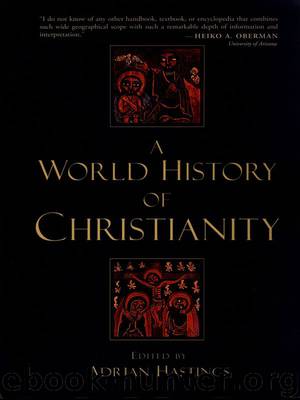A World History of Christianity by Unknown

Author:Unknown
Language: eng
Format: epub
ISBN: 0802848753
Publisher: Eerdmans Publishing Co - A
Published: 2011-10-24T00:00:00+00:00
The Caucasus between Russians and Ottomans
In the eleventh and twelfth centuries Georgia produced a distinct Christian culture and civilization, noted for its literature and architecture (churches and monasteries). The official date for the Christianization of Georgia is 330, and the Georgian Orthodox Church gained autocephaly in 1057, over 500 years before the Russian Orthodox Church. From the early twelfth century Armenians fleeing north from their occupied territories settled in Georgian towns, and for centuries Armenian merchants and Georgian nobles lived symbiotically. The medieval Georgian kingdom reached its apogee under Queen Tamar (1184–1212). After the Mongol invasion in 1236, however, Georgia fragmented once again into independent principalities.
It was not until the eighteenth century that growing commercial, political and intellectual ties with Russia led to a period of national revival, accompanied by intensified publication and educational activity which was predominantly religious in nature.21 From 1780 Catherine the Great decided to risk antagonizing the Turks and began taking control of the various warring Georgian kingdoms. The Georgian social structure remained intact: the king; the nobles with their landholdings and peasantry; the merchants with their prerogatives in the towns; the Church with its monopoly on education. The Church retained its autocephaly, and its head gained a seat on the Holy Synod of the Russian Orthodox Church.
In both Georgia and Armenia general education was in the hands of the clergy. In Georgia the village priest would often be the only local educated person and frequently the teacher of the young nobles. Church services were a central part of village life and the church was where people gathered socially. Russian response to revolts in Georgia in the early nineteenth century included removing the autocephaly of the Georgian Church in 1811, appointing a Russian archbishop as exarch and putting plans in place to replace Georgian with Slavonic rites. These moves stoked further resentment.
In the half-century before the Crimean war, Georgian society underwent fundamental changes. The rebellious semi-independent dynasts were transformed into a service gentry loyal to their new monarch, the Russian tsar. In the process they were introduced to Western education, and this eventually brought with it revolutionary ideas. In the later nineteenth century, after the death of Tsar Alexander II, growing Russian chauvinism clashed with the developing Georgian national consciousness. In 1886 a student at Tiflis seminary fatally stabbed the Russian rector. The seminary had long been a centre of student political activity. Russian reprisals for the murder led to protests of a political nature: thus the Church and its educational institutions were the crucible for nationalist revolutionary protest.
South of Georgia, the historical Armenian homeland had long been under Ottoman control. The Armenians within the Russian Empire, however, became the dominant commercial class in the region in the decades after the Crimean war, and following old traditions gave money to the Church for educational purposes. In 1836 the Russians had given the Armenian Church a large measure of internal autonomy as well as responsibility for education, and this was to work to the benefit of the whole Armenian people.
Download
This site does not store any files on its server. We only index and link to content provided by other sites. Please contact the content providers to delete copyright contents if any and email us, we'll remove relevant links or contents immediately.
Kathy Andrews Collection by Kathy Andrews(11738)
The remains of the day by Kazuo Ishiguro(8832)
Paper Towns by Green John(5093)
Spare by Prince Harry The Duke of Sussex(5078)
Industrial Automation from Scratch: A hands-on guide to using sensors, actuators, PLCs, HMIs, and SCADA to automate industrial processes by Olushola Akande(5001)
The Body: A Guide for Occupants by Bill Bryson(4978)
Machine Learning at Scale with H2O by Gregory Keys | David Whiting(4200)
Be in a Treehouse by Pete Nelson(3956)
Never by Ken Follett(3801)
Harry Potter and the Goblet Of Fire by J.K. Rowling(3776)
Goodbye Paradise(3730)
Into Thin Air by Jon Krakauer(3315)
The Remains of the Day by Kazuo Ishiguro(3296)
The Cellar by Natasha Preston(3265)
Fairy Tale by Stephen King(3229)
The Genius of Japanese Carpentry by Azby Brown(3228)
120 Days of Sodom by Marquis de Sade(3185)
Drawing Shortcuts: Developing Quick Drawing Skills Using Today's Technology by Leggitt Jim(3001)
The Man Who Died Twice by Richard Osman(2998)
